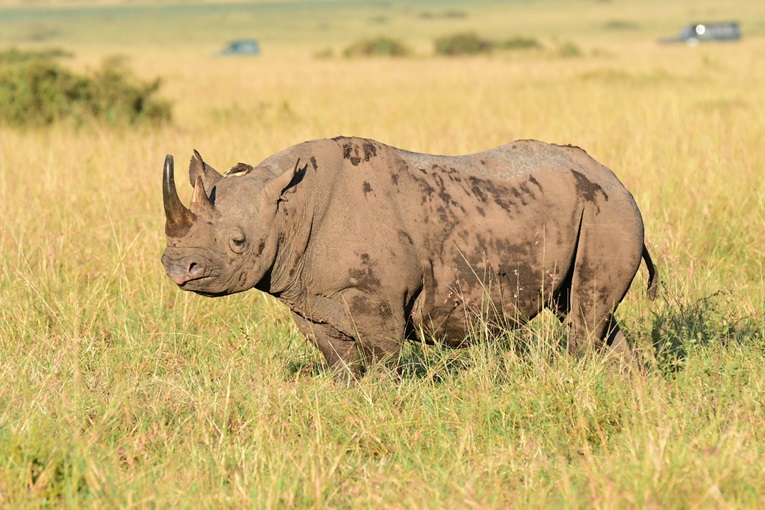
Photo by: Shaun Spykerman
Rhinoceroses (or rhinos) are large, herbivorous mammals that can be identified by their characteristic horned snouts. There are only five extant species of rhinos left in the world, and three of them are listed as critically endangered based on the IUCN’s Red List of Threatened Species:
- Black Rhino (Diceros bicornis) - found in Africa, critically endangered
- White Rhino (Ceratotherium simum) - found in Africa, near threatened
- Sumatran Rhino (Dicerorhinus sumatrensis) - found in Sumatra & Borneo, critically endangered
- Javan Rhino (Rhinoceros sondaicus) - found in Java, critically endangered
- Indian/Greater one-horned Rhino (Rhinoceros unicornis) - found in India & Nepa, vulnerable
Their populations have dropped drastically, from 500,000 individuals in the early 20th century to 70,000 individuals by 1970, to as few as 25,000 remaining in the wild today. Although conservation efforts have seen success in recent years, rhinos have difficulty surviving in the wild due to habitat degradation and persistent poaching pressure.
Rhinos are primarily poached for their horns - which are mostly sold in Asian countries as a high-value gift item or as traditional medicine (in the form of powders and small fragments) believed to contain medicinal values in treating ailments such as fever and arthritis. Due to the rising affluence in the growing middle class in some Asian countries, there has been a surge in demand for rhino horns in the past few decades. Between 2007 and 2014, the number of rhinos poached in South Africa increased by 9,000%, from 13 to 1,215 individuals, and decreased to 594 in 2019.
Trade regulations for rhino horns
Under the Convention on International Trade in Endangered Species of Wild Fauna and Flora (CITES), international trade in rhino horn is prohibited. Amongst the five rhino species, the Javan, Sumatran, Black and Greater one-horned rhinos are listed under CITES Appendix I, which strictly prohibits trade in these species and their products as it could lead to extinction of the species.
Singapore has been a Party to CITES since November 1986. As such, it is illegal to import and export rhino horns in Singapore under the Endangered Species (Import and Export) Act (Cap. 92A). Under this Act, it is an offence to possess, sell, offer for sale, or publicly display any CITES species, as well as their parts and derivatives without the necessary CITES permits.
Identification of rhinoceros horns

A rhino’s horn is made of keratin, which is also a component found in pangolin scales, saiga horns, human hair and fingernails. Each horn is made of a tuft of hair tightly packed together and glued by exudates from the sebaceous glands on the rhino’s nose. In addition, dense mineral deposits of calcium and melanin are also found at the core of the horn, which makes the horn more resistant to physical wear and breakdown.
As a result of rising demand for rhino horns in recent years, there has been an increase in the number of imitation rhino horns which are obtained or made from the horns of water buffalos and cattle, bones, wood, synthetic material or even horse’s hair. A variety of methods such as microscopy, thin layer chromatography, Infrared spectroscopy, modern genetic techniques, and more can be employed to distinguish a genuine rhino horn from an imitation. Our forensics capabilities will tell us if powdered rhino horn can be identified if a smuggler tried to pass it off as powdered horn of a non-CITES animal or tried to pass off a real Rhino horn as a fake one to confuse authorities.

Image source: https://www.fws.gov/lab/idnotes/IDG_13_RhinoHorn.pdf
To differentiate a rhino horn from a cattle horn, macroscopic observations can be used for preliminary identification. In cattle, the horn sheath is hollow on the inside as it used to cover the horn core (bone) attached to the skull of the cattle. However, rhino horns do not possess this hollow core as they contain solid keratin throughout. Other methods such as Infrared spectroscopy can also be employed to differentiate a rhino’s horn from other horns as the infrared spectra of a rhino’s horn is significantly different from that of other horns.
To identify rhino horns on a species level, genetic techniques can be employed, which are important in wildlife forensics to combat the illegal wildlife poaching as they are a form of legal evidence and they allow the tracing of seized shipments to the traffickers.
How can you help?
If you spot any occurrences of illegal wildlife trade, and ownership of endangered or wild species and its parts, you may contact NParks using the online feedback form or call 1800-476-1600. All information shared with NParks will be kept confidential.
If there is a need to import or export any products from CITES-listed species, permits and certificates can be applied through NParks.